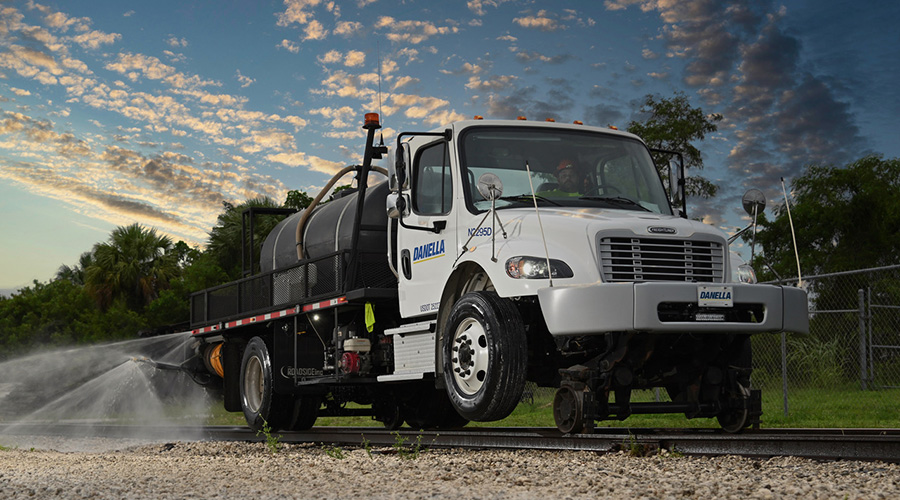Stay updated on news, articles and information for the rail industry
December 2023
Rail News: MOW
Contractor Outlook 2024: Sector's strength, resiliency to continue in '24

Compiled by Pat Foran, Editor-in-Chief
In the aggregate, railroad contractors tell us they had a good 2023, and expect the good times to last at least in the near term for a range of reasons, particularly as record grant funding levels begin to trickle down to their portion of the industry.
Witness the Federal Railroad Administration’s September announcement that it would award $1.4 billion in Consolidated Rail Infrastructure and Safety Improvements (CRISI) program grants to fund 70 rail improvement projects in 35 states. The funding will address long-standing rail needs, including track improvements, bridge rehabilitations, and grade crossing eliminations and upgrades on hazardous material routes.
And while they won’t know how much North American freight and passenger railroads plan to set aside for contract infrastructure work next year, contractors know there will be plenty of must-complete projects on their dockets. Whatever the economic weather.
Concerns? Contractors have a few, ranging from the rising cost of doing business to lingering workforce recruitment and retention challenges (their own, as well as railroads’).
What are their 2024 forecasts for the railroad contracting segment and their respective businesses? How are they gearing up to prepare for the year ahead?
Five representatives from the North American railroad contracting segment shared answers with us via email: Ashley Wieland, president of the National Railroad Construction and Maintenance Association (NRC); Russell Gehl, executive vice president of business development for Holland; Gary Kohnert, director of North American sales for Loram Maintenance of Way; Brett Urquhart, president of Martinus North America; and Shane Stalford, chief operating officer of Omaha Track.
Ashley Wieland, NRC

The railroad contracting business this past year was very strong. We are coming off several good years even in light of a global pandemic and threats of recession.
Rail grant programs that received record funding levels from the Infrastructure Investment and Jobs Act are just now starting to trickle down to the rail contractor and supply community, and will continue to do so over the next year. In particular, record Amtrak funding; CRISI, Railroad Crossing Elimination and Federal-State Partnership grants from the Federal Railroad Administration; and the Federal Transit Administration’s New Starts grants will continue to provide a steady stream of opportunities for railroad contractors.
Class I capital expenditures have remained consistently strong in recent years, and we will see how some of the recent announcements of layoffs from some of the major railroads will either potentially increase opportunities for NRC members and/or put additional pressure on contracts and vendors. We will learn more at the NRC 2024 Conference to be held in Scottsdale next month.
“The railroad contracting business this past year was very strong. We are coming off several good years even in light of a global pandemic and threats of recession.”
— Ashley Wieland, NRC
Meanwhile, sustainability continues to be an increased topic of interest to railroad contractors. Railroad customers have very ambitious environmental, social and governance goals, and they are feeling these sustainability pressures from their customers, which is causing railroads to move quickly to implement programs to monitor sustainability metrics and reduce their carbon footprint.
This is trickling down to railroad contractors and suppliers. There is a lot of interest from the contractor community in working closely with the railroads to reach those sustainability goals.
We have formed a sustainability committee made up of NRC members who are working closely with sustainability counterparts at the major railroads so that our industry may have a concerted effort to minimize our environmental impact and reduce our carbon footprint. The goal for this committee is to eventually provide resources for some of our smaller contractor members so they don’t fall behind.
Russell Gehl, Holland
It’s been an extremely busy year for Holland in 2023. We saw record growth in Mexico and a significant uptick in projects throughout the United States and Canada. We are optimistic for 2024, but will not see the same growth as we experienced in 2023.
Holland is excited about customer adoption of our new technologies and processes that drive the utilization of flash-butt welding. We are concerned about the Class I rail program volume, but see a strong push toward growth in defect and joint remediation through flash-butt welding.
The lack of labor at a track level will continue to drive added services around the flash-butt welders, which helps drive the business, as well. Holland is also very excited about the continued growth and utilization of our Holland Automated Manganese Repair (HAMR) system and its impact on extending the life of frogs and diamonds for our customers.
The biggest concern for 2024 is to have a quality labor force available to work on the track. Safety and quality are key measurements for Holland and our customers. In 2024, we will make solid investments in Holland’s training facility as well as classroom and field curriculum.
We continue to invest in our safety program through new training programs and resources to offer expanded field engagement and audit teams. We have also added new technology to help with driving safety and pre-trip inspections.
Holland continues to invest in its fleet and technology, so another concern is the lead time and availability of critical and new components. With expanded purchasing resources and the introduction of some automation tools, we are reaching out to sourcing options to reduce lead times and sometimes costs.
Gary Kohnert, Loram Maintenance of Way

The North America freight-rail market continues to remain resilient despite 2023’s headwinds. Loram’s 2024 forecast mirrors 2023; however, Loram is optimistic that reduced inflation will have a positive impact on the economy, benefiting freight-rail traffic and all in the rail industry.
“Loram is optimistic that reduced inflation will have a positive impact on the economy, benefiting freight-rail traffic and all in the rail industry.”
— Gary Kohnert, Loram Maintenance of Way
With increased rail traffic, the planning of maintenance-of-way activities becomes even more challenging due to reduced trackwork windows. Therefore, it’s Loram’s commitment to not only deliver a safety-first service, but a service with reliable equipment operating at the highest level of performance and quality to maximize track work windows.
Loram remains committed to investigating technological and service advancements that optimize work programs for our customers.
Brett Urquhart, Martinus North America

Martinus is seeing new opportunities due to our recent investments in the market. In August, we completed an acquisition that is now our rail services subsidiary, Martinus Bottom Line. We now have more capability in our track, bridge and RWIC departments, and this is leading to growth for our North American business.
“Our biggest concern will always be the investment in projects that get reduced or eliminated by the political landscape, when contractors have put time and money into preparation for these jobs.”
— Brett Urquhart, Martinus North America
As a business, we are always investing in people and the ability to respond to major projects when they become shovel-ready for the contracting market. Our biggest concern will always be the investment in projects that get reduced or eliminated by the political landscape, when contractors have put time and money into preparation for these jobs.
We continue to focus on the core markets of heavy haul, short line and industrial development in order to continue organic growth, but Martinus hopes these larger high-speed rail and transit projects come to fruition for the greater good of the market and U.S. infrastructure.
Shane Stalford, Omaha Track

We are optimistic about the 2024 forecast for the railroad contracting segment. The infusion of grant money into infrastructure projects is expected to drive substantial growth opportunities. There will be a significant focus on trackwork and upgrades, presenting a positive outlook for our business.
We anticipate that 2024 will be better for both the rail industry and our company compared to 2023. One key factor contributing to this improvement is the increasing availability of equipment. Recognizing the importance of being well-equipped to meet the growing demand, we are in the process of building our second equipment shop in Kansas City, Kansas. This strategic investment ensures that we have all the necessary resources to efficiently carry out projects and capitalize on the expanding market.
The rising costs of doing business, coupled with inflationary pressures, pose challenges to competitive bidding. We acknowledge the importance of maintaining cost-effectiveness in our operations to stay competitive.
“The infusion of grant money into infrastructure projects is expected to drive substantial growth opportunities.”
— Shane Stalford, Omaha Track
Our organization is closely monitoring market trends, optimizing operational efficiencies and exploring strategic partnerships to mitigate the impact of inflation and cost increases. By staying agile and adaptive, we aim to navigate these challenges successfully and continue to deliver value to our clients.
Another concern for the coming year revolves around securing qualified personnel. The nature of our industry requires a workforce that is willing to travel extensively. With the current trend of work-from-home opportunities gaining popularity, finding qualified employees willing to commit to travel becomes increasingly challenging.
To address this concern, our organization is implementing proactive measures to attract and retain qualified talent. This includes exploring flexible work arrangements where possible and investing in training and development programs.
We understand that a skilled and dedicated workforce is essential to our success, and we are committed to creating an environment that fosters professional growth and job satisfaction.
Email questions or comments to pat.foran@tradepress.com.
Keywords
Browse articles on 2024 railroad contractor outlook 2024 forecast Ashley Wieland NRC Russell Gehl Holland CRISI Consolidated Rail Infrastructure and Safety Improvements program grants Gary Kohnert Loram Maintenance of Way Brett Urquhart Martinus North America Shane Stalford Omaha TrackContact Progressive Railroading editorial staff.


 2025 MOW Spending Report: Passenger-rail programs
2025 MOW Spending Report: Passenger-rail programs
 Gardner steps down as Amtrak CEO
Gardner steps down as Amtrak CEO
 Guest comment: Oliver Wyman’s David Hunt
Guest comment: Oliver Wyman’s David Hunt
 Women of Influence in Rail eBook
Women of Influence in Rail eBook
 railPrime
railPrime






